Law and Ethics in Nursing
VerifiedAdded on 2023/01/11
|12
|3610
|97
AI Summary
This study focuses on the case of a 17-year-old patient and the conflict between law and ethics in nursing. Explore the legal and ethical aspects of healthcare decisions and the role of Australian law and ethics in this comprehensive study.
Contribute Materials
Your contribution can guide someone’s learning journey. Share your
documents today.
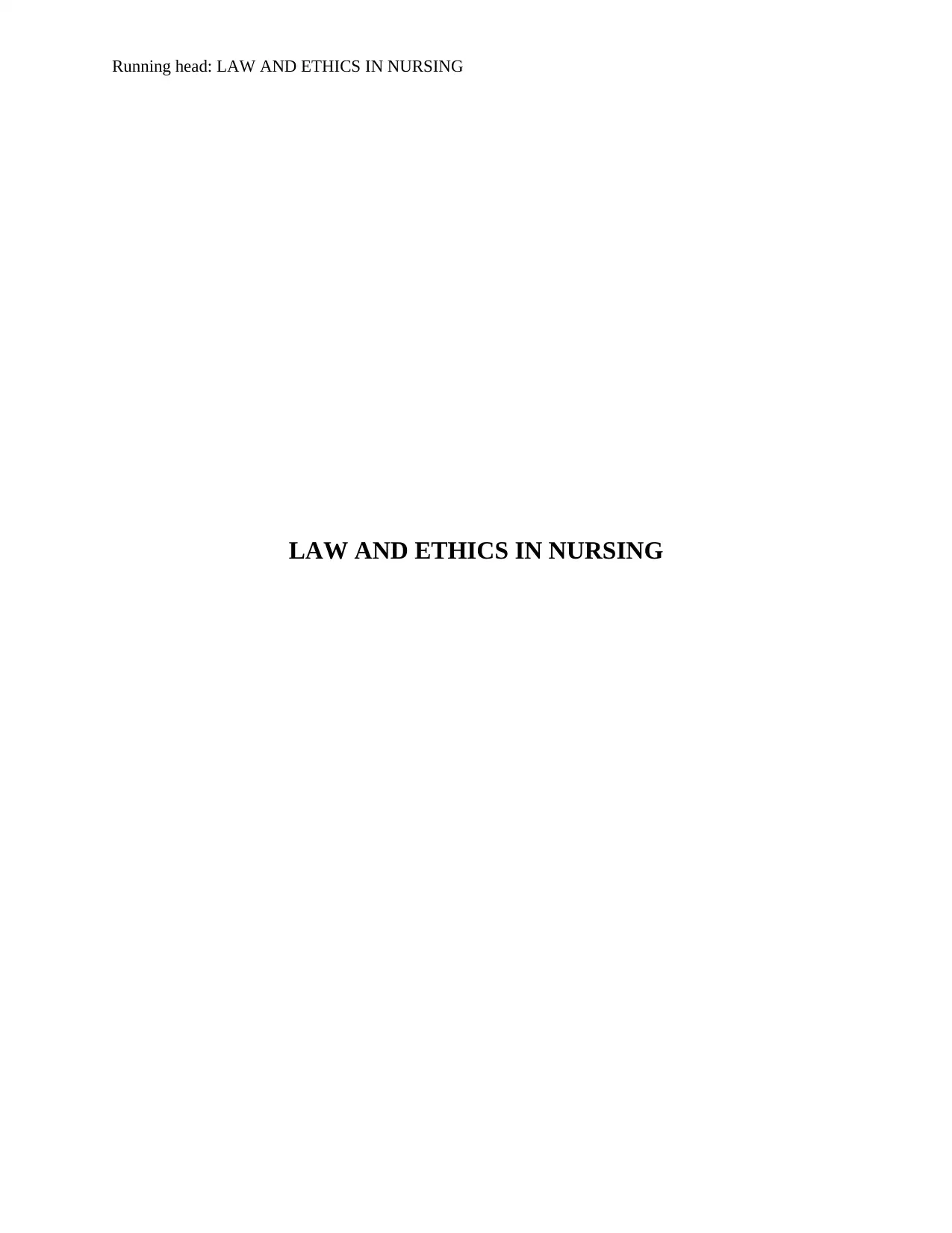
Running head: LAW AND ETHICS IN NURSING
LAW AND ETHICS IN NURSING
LAW AND ETHICS IN NURSING
Secure Best Marks with AI Grader
Need help grading? Try our AI Grader for instant feedback on your assignments.
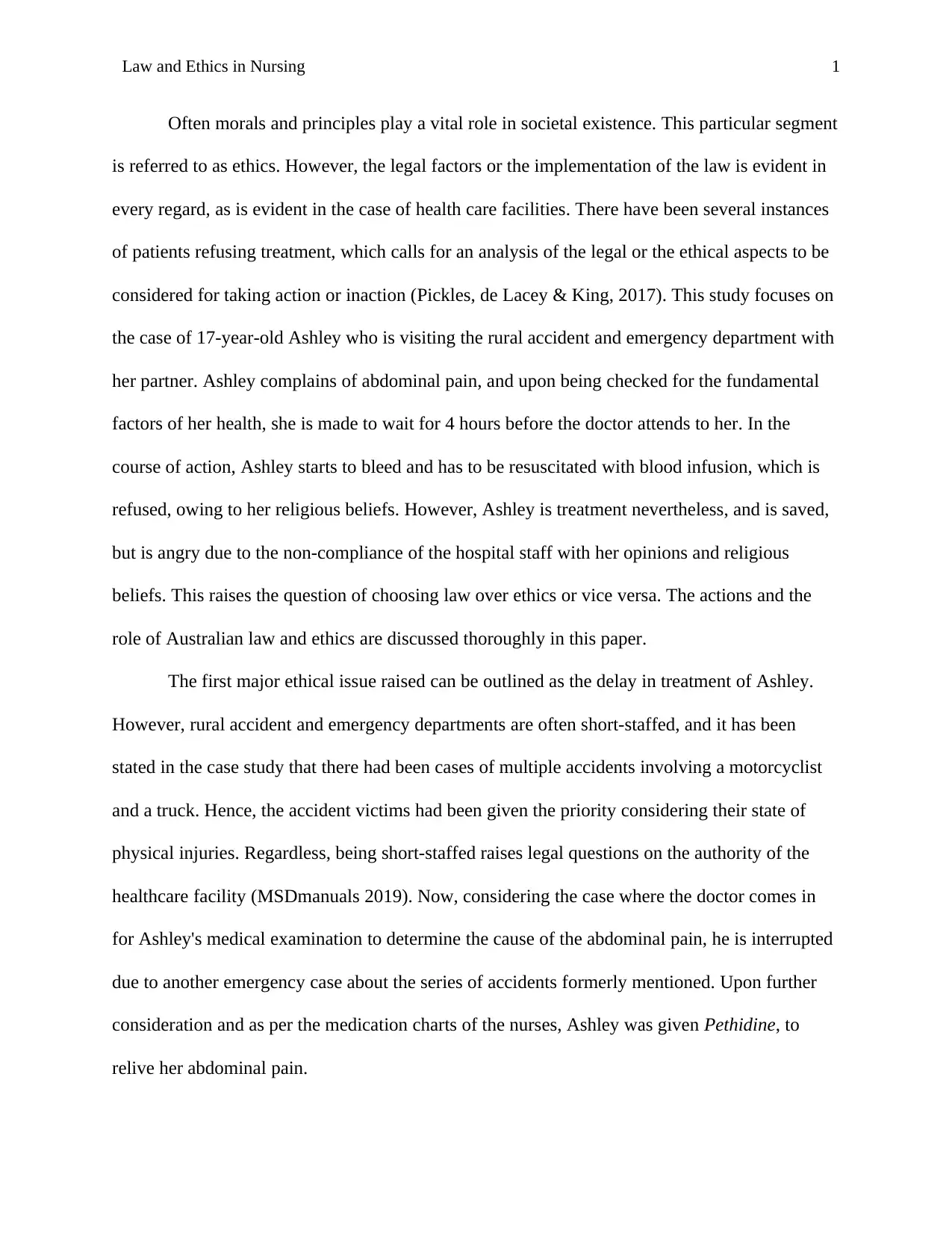
Law and Ethics in Nursing 1
Often morals and principles play a vital role in societal existence. This particular segment
is referred to as ethics. However, the legal factors or the implementation of the law is evident in
every regard, as is evident in the case of health care facilities. There have been several instances
of patients refusing treatment, which calls for an analysis of the legal or the ethical aspects to be
considered for taking action or inaction (Pickles, de Lacey & King, 2017). This study focuses on
the case of 17-year-old Ashley who is visiting the rural accident and emergency department with
her partner. Ashley complains of abdominal pain, and upon being checked for the fundamental
factors of her health, she is made to wait for 4 hours before the doctor attends to her. In the
course of action, Ashley starts to bleed and has to be resuscitated with blood infusion, which is
refused, owing to her religious beliefs. However, Ashley is treatment nevertheless, and is saved,
but is angry due to the non-compliance of the hospital staff with her opinions and religious
beliefs. This raises the question of choosing law over ethics or vice versa. The actions and the
role of Australian law and ethics are discussed thoroughly in this paper.
The first major ethical issue raised can be outlined as the delay in treatment of Ashley.
However, rural accident and emergency departments are often short-staffed, and it has been
stated in the case study that there had been cases of multiple accidents involving a motorcyclist
and a truck. Hence, the accident victims had been given the priority considering their state of
physical injuries. Regardless, being short-staffed raises legal questions on the authority of the
healthcare facility (MSDmanuals 2019). Now, considering the case where the doctor comes in
for Ashley's medical examination to determine the cause of the abdominal pain, he is interrupted
due to another emergency case about the series of accidents formerly mentioned. Upon further
consideration and as per the medication charts of the nurses, Ashley was given Pethidine, to
relive her abdominal pain.
Often morals and principles play a vital role in societal existence. This particular segment
is referred to as ethics. However, the legal factors or the implementation of the law is evident in
every regard, as is evident in the case of health care facilities. There have been several instances
of patients refusing treatment, which calls for an analysis of the legal or the ethical aspects to be
considered for taking action or inaction (Pickles, de Lacey & King, 2017). This study focuses on
the case of 17-year-old Ashley who is visiting the rural accident and emergency department with
her partner. Ashley complains of abdominal pain, and upon being checked for the fundamental
factors of her health, she is made to wait for 4 hours before the doctor attends to her. In the
course of action, Ashley starts to bleed and has to be resuscitated with blood infusion, which is
refused, owing to her religious beliefs. However, Ashley is treatment nevertheless, and is saved,
but is angry due to the non-compliance of the hospital staff with her opinions and religious
beliefs. This raises the question of choosing law over ethics or vice versa. The actions and the
role of Australian law and ethics are discussed thoroughly in this paper.
The first major ethical issue raised can be outlined as the delay in treatment of Ashley.
However, rural accident and emergency departments are often short-staffed, and it has been
stated in the case study that there had been cases of multiple accidents involving a motorcyclist
and a truck. Hence, the accident victims had been given the priority considering their state of
physical injuries. Regardless, being short-staffed raises legal questions on the authority of the
healthcare facility (MSDmanuals 2019). Now, considering the case where the doctor comes in
for Ashley's medical examination to determine the cause of the abdominal pain, he is interrupted
due to another emergency case about the series of accidents formerly mentioned. Upon further
consideration and as per the medication charts of the nurses, Ashley was given Pethidine, to
relive her abdominal pain.
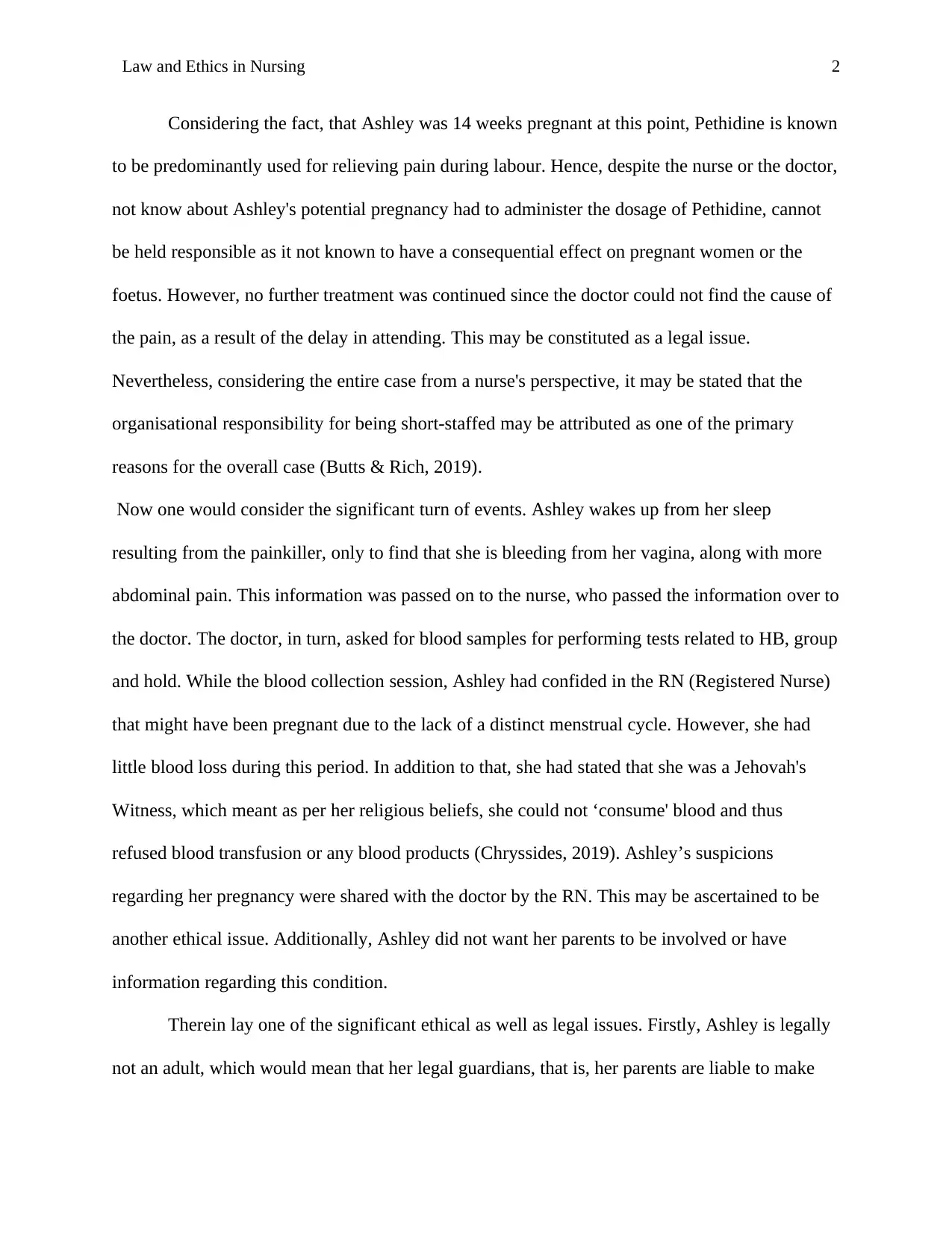
Law and Ethics in Nursing 2
Considering the fact, that Ashley was 14 weeks pregnant at this point, Pethidine is known
to be predominantly used for relieving pain during labour. Hence, despite the nurse or the doctor,
not know about Ashley's potential pregnancy had to administer the dosage of Pethidine, cannot
be held responsible as it not known to have a consequential effect on pregnant women or the
foetus. However, no further treatment was continued since the doctor could not find the cause of
the pain, as a result of the delay in attending. This may be constituted as a legal issue.
Nevertheless, considering the entire case from a nurse's perspective, it may be stated that the
organisational responsibility for being short-staffed may be attributed as one of the primary
reasons for the overall case (Butts & Rich, 2019).
Now one would consider the significant turn of events. Ashley wakes up from her sleep
resulting from the painkiller, only to find that she is bleeding from her vagina, along with more
abdominal pain. This information was passed on to the nurse, who passed the information over to
the doctor. The doctor, in turn, asked for blood samples for performing tests related to HB, group
and hold. While the blood collection session, Ashley had confided in the RN (Registered Nurse)
that might have been pregnant due to the lack of a distinct menstrual cycle. However, she had
little blood loss during this period. In addition to that, she had stated that she was a Jehovah's
Witness, which meant as per her religious beliefs, she could not ‘consume' blood and thus
refused blood transfusion or any blood products (Chryssides, 2019). Ashley’s suspicions
regarding her pregnancy were shared with the doctor by the RN. This may be ascertained to be
another ethical issue. Additionally, Ashley did not want her parents to be involved or have
information regarding this condition.
Therein lay one of the significant ethical as well as legal issues. Firstly, Ashley is legally
not an adult, which would mean that her legal guardians, that is, her parents are liable to make
Considering the fact, that Ashley was 14 weeks pregnant at this point, Pethidine is known
to be predominantly used for relieving pain during labour. Hence, despite the nurse or the doctor,
not know about Ashley's potential pregnancy had to administer the dosage of Pethidine, cannot
be held responsible as it not known to have a consequential effect on pregnant women or the
foetus. However, no further treatment was continued since the doctor could not find the cause of
the pain, as a result of the delay in attending. This may be constituted as a legal issue.
Nevertheless, considering the entire case from a nurse's perspective, it may be stated that the
organisational responsibility for being short-staffed may be attributed as one of the primary
reasons for the overall case (Butts & Rich, 2019).
Now one would consider the significant turn of events. Ashley wakes up from her sleep
resulting from the painkiller, only to find that she is bleeding from her vagina, along with more
abdominal pain. This information was passed on to the nurse, who passed the information over to
the doctor. The doctor, in turn, asked for blood samples for performing tests related to HB, group
and hold. While the blood collection session, Ashley had confided in the RN (Registered Nurse)
that might have been pregnant due to the lack of a distinct menstrual cycle. However, she had
little blood loss during this period. In addition to that, she had stated that she was a Jehovah's
Witness, which meant as per her religious beliefs, she could not ‘consume' blood and thus
refused blood transfusion or any blood products (Chryssides, 2019). Ashley’s suspicions
regarding her pregnancy were shared with the doctor by the RN. This may be ascertained to be
another ethical issue. Additionally, Ashley did not want her parents to be involved or have
information regarding this condition.
Therein lay one of the significant ethical as well as legal issues. Firstly, Ashley is legally
not an adult, which would mean that her legal guardians, that is, her parents are liable to make
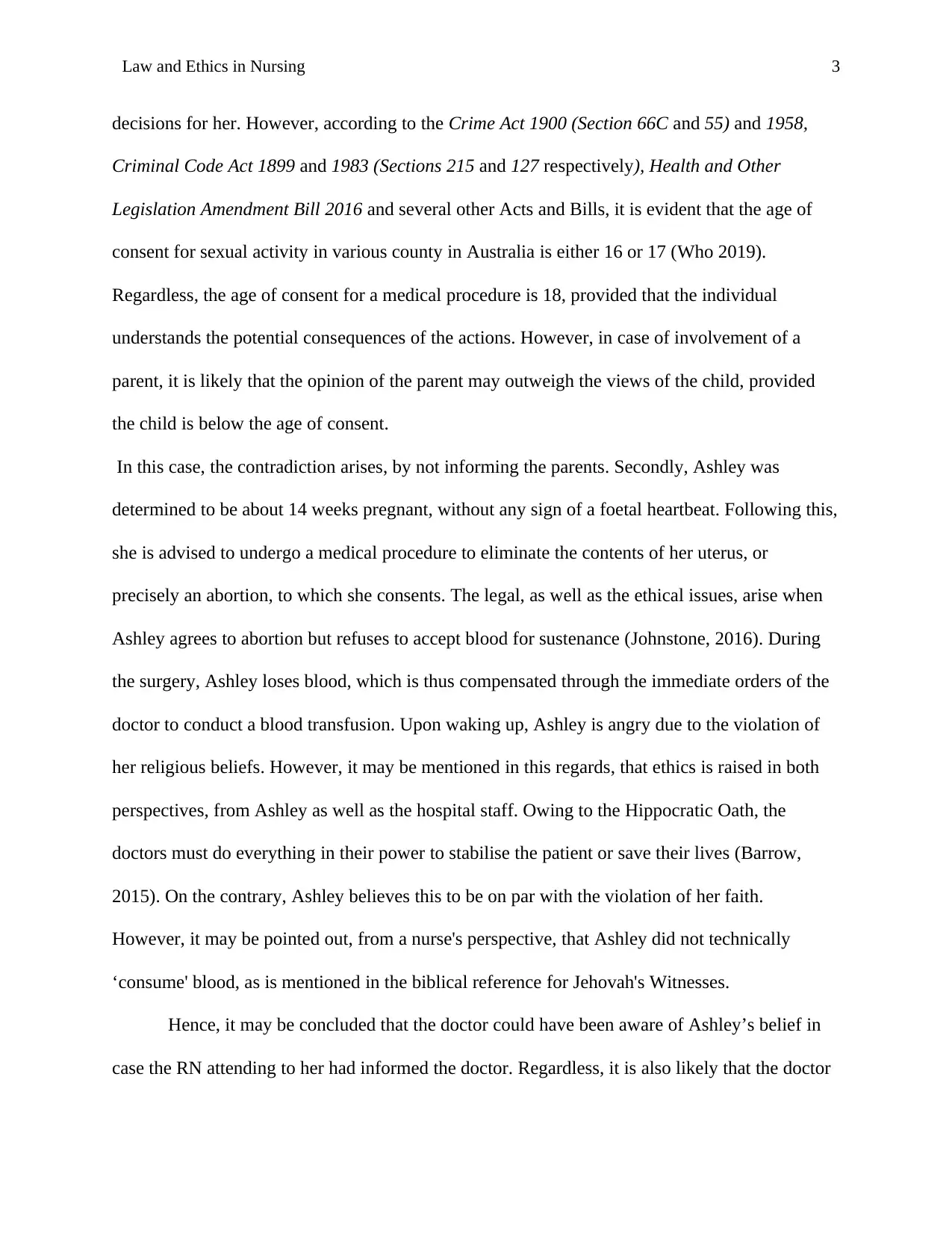
Law and Ethics in Nursing 3
decisions for her. However, according to the Crime Act 1900 (Section 66C and 55) and 1958,
Criminal Code Act 1899 and 1983 (Sections 215 and 127 respectively), Health and Other
Legislation Amendment Bill 2016 and several other Acts and Bills, it is evident that the age of
consent for sexual activity in various county in Australia is either 16 or 17 (Who 2019).
Regardless, the age of consent for a medical procedure is 18, provided that the individual
understands the potential consequences of the actions. However, in case of involvement of a
parent, it is likely that the opinion of the parent may outweigh the views of the child, provided
the child is below the age of consent.
In this case, the contradiction arises, by not informing the parents. Secondly, Ashley was
determined to be about 14 weeks pregnant, without any sign of a foetal heartbeat. Following this,
she is advised to undergo a medical procedure to eliminate the contents of her uterus, or
precisely an abortion, to which she consents. The legal, as well as the ethical issues, arise when
Ashley agrees to abortion but refuses to accept blood for sustenance (Johnstone, 2016). During
the surgery, Ashley loses blood, which is thus compensated through the immediate orders of the
doctor to conduct a blood transfusion. Upon waking up, Ashley is angry due to the violation of
her religious beliefs. However, it may be mentioned in this regards, that ethics is raised in both
perspectives, from Ashley as well as the hospital staff. Owing to the Hippocratic Oath, the
doctors must do everything in their power to stabilise the patient or save their lives (Barrow,
2015). On the contrary, Ashley believes this to be on par with the violation of her faith.
However, it may be pointed out, from a nurse's perspective, that Ashley did not technically
‘consume' blood, as is mentioned in the biblical reference for Jehovah's Witnesses.
Hence, it may be concluded that the doctor could have been aware of Ashley’s belief in
case the RN attending to her had informed the doctor. Regardless, it is also likely that the doctor
decisions for her. However, according to the Crime Act 1900 (Section 66C and 55) and 1958,
Criminal Code Act 1899 and 1983 (Sections 215 and 127 respectively), Health and Other
Legislation Amendment Bill 2016 and several other Acts and Bills, it is evident that the age of
consent for sexual activity in various county in Australia is either 16 or 17 (Who 2019).
Regardless, the age of consent for a medical procedure is 18, provided that the individual
understands the potential consequences of the actions. However, in case of involvement of a
parent, it is likely that the opinion of the parent may outweigh the views of the child, provided
the child is below the age of consent.
In this case, the contradiction arises, by not informing the parents. Secondly, Ashley was
determined to be about 14 weeks pregnant, without any sign of a foetal heartbeat. Following this,
she is advised to undergo a medical procedure to eliminate the contents of her uterus, or
precisely an abortion, to which she consents. The legal, as well as the ethical issues, arise when
Ashley agrees to abortion but refuses to accept blood for sustenance (Johnstone, 2016). During
the surgery, Ashley loses blood, which is thus compensated through the immediate orders of the
doctor to conduct a blood transfusion. Upon waking up, Ashley is angry due to the violation of
her religious beliefs. However, it may be mentioned in this regards, that ethics is raised in both
perspectives, from Ashley as well as the hospital staff. Owing to the Hippocratic Oath, the
doctors must do everything in their power to stabilise the patient or save their lives (Barrow,
2015). On the contrary, Ashley believes this to be on par with the violation of her faith.
However, it may be pointed out, from a nurse's perspective, that Ashley did not technically
‘consume' blood, as is mentioned in the biblical reference for Jehovah's Witnesses.
Hence, it may be concluded that the doctor could have been aware of Ashley’s belief in
case the RN attending to her had informed the doctor. Regardless, it is also likely that the doctor
Secure Best Marks with AI Grader
Need help grading? Try our AI Grader for instant feedback on your assignments.
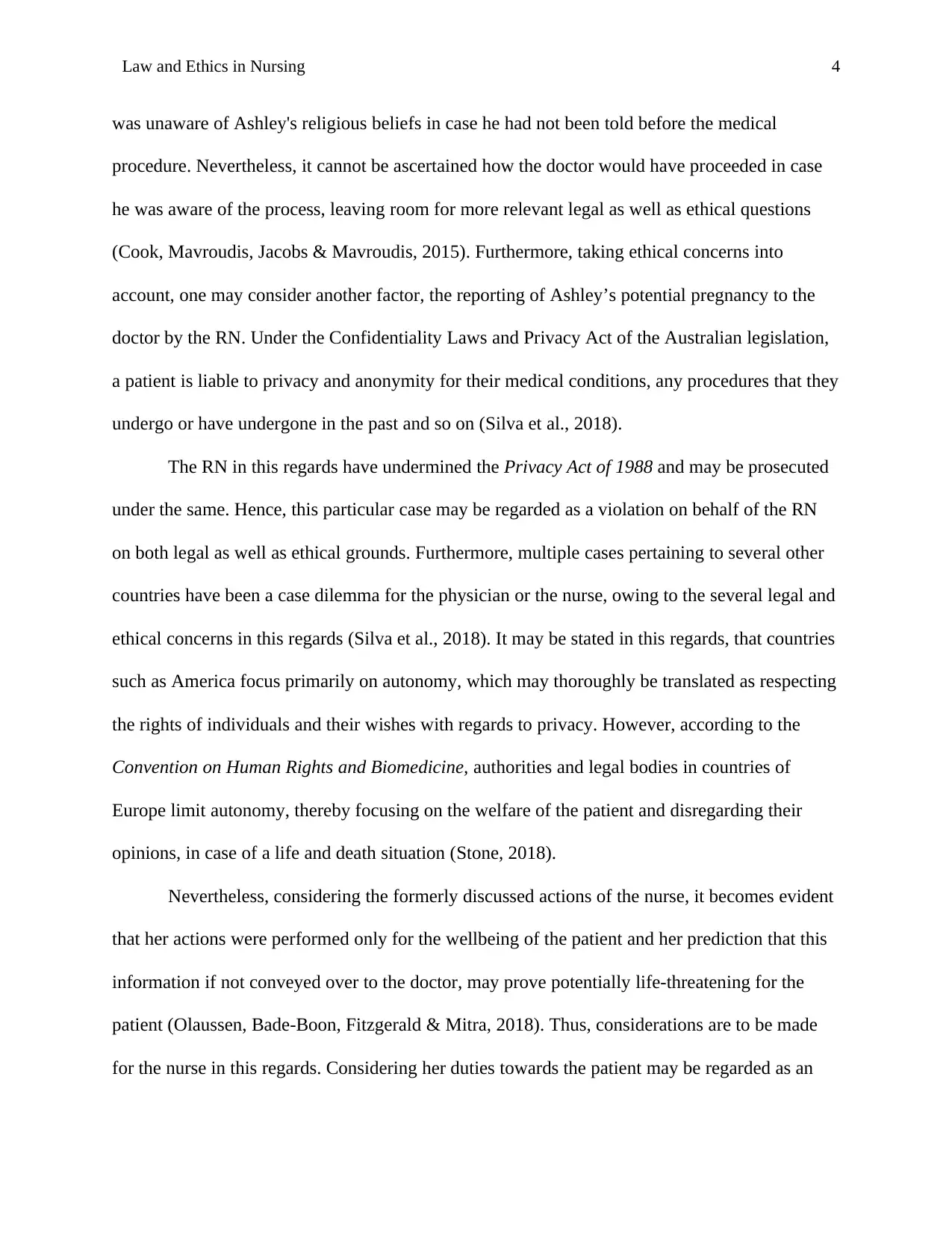
Law and Ethics in Nursing 4
was unaware of Ashley's religious beliefs in case he had not been told before the medical
procedure. Nevertheless, it cannot be ascertained how the doctor would have proceeded in case
he was aware of the process, leaving room for more relevant legal as well as ethical questions
(Cook, Mavroudis, Jacobs & Mavroudis, 2015). Furthermore, taking ethical concerns into
account, one may consider another factor, the reporting of Ashley’s potential pregnancy to the
doctor by the RN. Under the Confidentiality Laws and Privacy Act of the Australian legislation,
a patient is liable to privacy and anonymity for their medical conditions, any procedures that they
undergo or have undergone in the past and so on (Silva et al., 2018).
The RN in this regards have undermined the Privacy Act of 1988 and may be prosecuted
under the same. Hence, this particular case may be regarded as a violation on behalf of the RN
on both legal as well as ethical grounds. Furthermore, multiple cases pertaining to several other
countries have been a case dilemma for the physician or the nurse, owing to the several legal and
ethical concerns in this regards (Silva et al., 2018). It may be stated in this regards, that countries
such as America focus primarily on autonomy, which may thoroughly be translated as respecting
the rights of individuals and their wishes with regards to privacy. However, according to the
Convention on Human Rights and Biomedicine, authorities and legal bodies in countries of
Europe limit autonomy, thereby focusing on the welfare of the patient and disregarding their
opinions, in case of a life and death situation (Stone, 2018).
Nevertheless, considering the formerly discussed actions of the nurse, it becomes evident
that her actions were performed only for the wellbeing of the patient and her prediction that this
information if not conveyed over to the doctor, may prove potentially life-threatening for the
patient (Olaussen, Bade‐Boon, Fitzgerald & Mitra, 2018). Thus, considerations are to be made
for the nurse in this regards. Considering her duties towards the patient may be regarded as an
was unaware of Ashley's religious beliefs in case he had not been told before the medical
procedure. Nevertheless, it cannot be ascertained how the doctor would have proceeded in case
he was aware of the process, leaving room for more relevant legal as well as ethical questions
(Cook, Mavroudis, Jacobs & Mavroudis, 2015). Furthermore, taking ethical concerns into
account, one may consider another factor, the reporting of Ashley’s potential pregnancy to the
doctor by the RN. Under the Confidentiality Laws and Privacy Act of the Australian legislation,
a patient is liable to privacy and anonymity for their medical conditions, any procedures that they
undergo or have undergone in the past and so on (Silva et al., 2018).
The RN in this regards have undermined the Privacy Act of 1988 and may be prosecuted
under the same. Hence, this particular case may be regarded as a violation on behalf of the RN
on both legal as well as ethical grounds. Furthermore, multiple cases pertaining to several other
countries have been a case dilemma for the physician or the nurse, owing to the several legal and
ethical concerns in this regards (Silva et al., 2018). It may be stated in this regards, that countries
such as America focus primarily on autonomy, which may thoroughly be translated as respecting
the rights of individuals and their wishes with regards to privacy. However, according to the
Convention on Human Rights and Biomedicine, authorities and legal bodies in countries of
Europe limit autonomy, thereby focusing on the welfare of the patient and disregarding their
opinions, in case of a life and death situation (Stone, 2018).
Nevertheless, considering the formerly discussed actions of the nurse, it becomes evident
that her actions were performed only for the wellbeing of the patient and her prediction that this
information if not conveyed over to the doctor, may prove potentially life-threatening for the
patient (Olaussen, Bade‐Boon, Fitzgerald & Mitra, 2018). Thus, considerations are to be made
for the nurse in this regards. Considering her duties towards the patient may be regarded as an
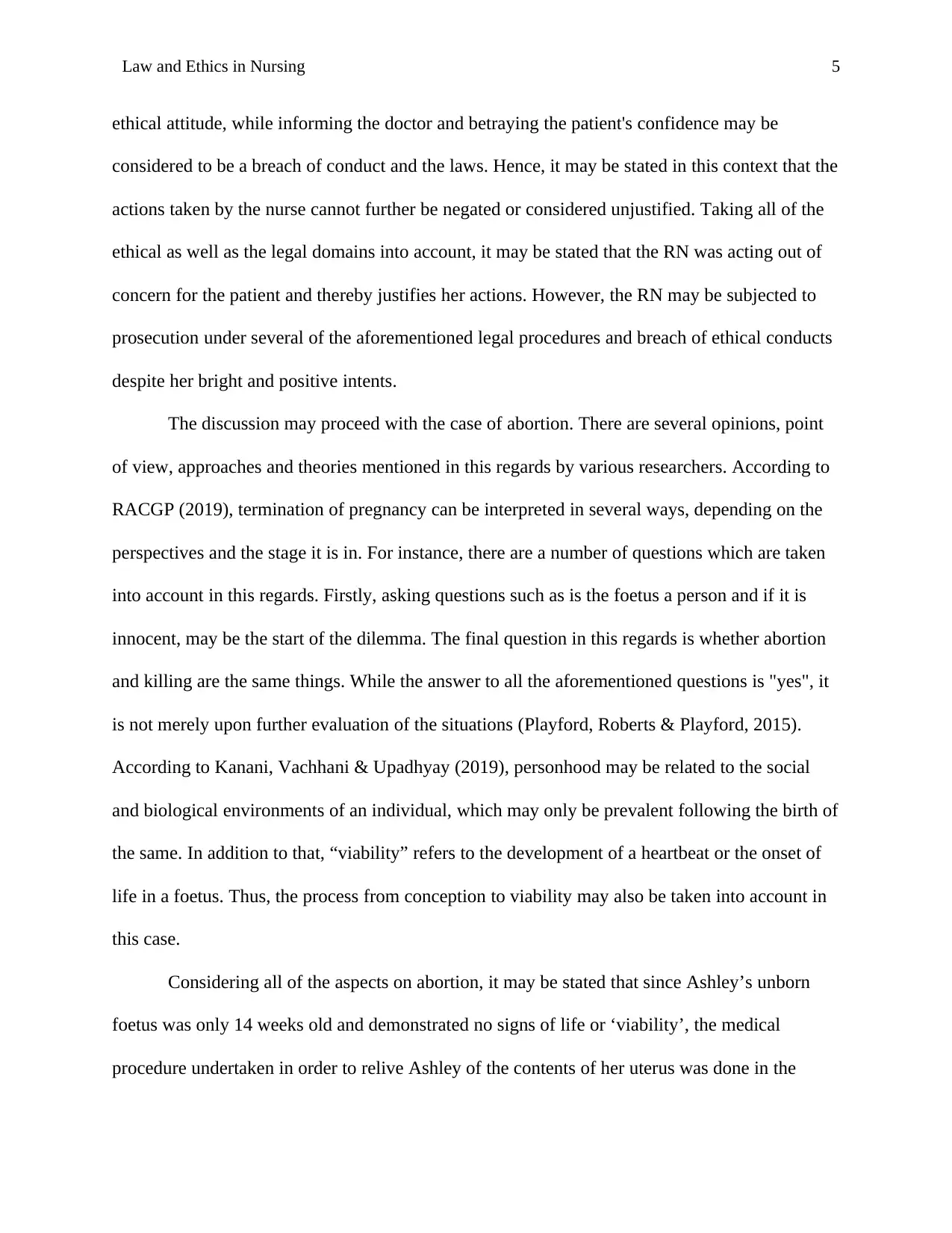
Law and Ethics in Nursing 5
ethical attitude, while informing the doctor and betraying the patient's confidence may be
considered to be a breach of conduct and the laws. Hence, it may be stated in this context that the
actions taken by the nurse cannot further be negated or considered unjustified. Taking all of the
ethical as well as the legal domains into account, it may be stated that the RN was acting out of
concern for the patient and thereby justifies her actions. However, the RN may be subjected to
prosecution under several of the aforementioned legal procedures and breach of ethical conducts
despite her bright and positive intents.
The discussion may proceed with the case of abortion. There are several opinions, point
of view, approaches and theories mentioned in this regards by various researchers. According to
RACGP (2019), termination of pregnancy can be interpreted in several ways, depending on the
perspectives and the stage it is in. For instance, there are a number of questions which are taken
into account in this regards. Firstly, asking questions such as is the foetus a person and if it is
innocent, may be the start of the dilemma. The final question in this regards is whether abortion
and killing are the same things. While the answer to all the aforementioned questions is "yes", it
is not merely upon further evaluation of the situations (Playford, Roberts & Playford, 2015).
According to Kanani, Vachhani & Upadhyay (2019), personhood may be related to the social
and biological environments of an individual, which may only be prevalent following the birth of
the same. In addition to that, “viability” refers to the development of a heartbeat or the onset of
life in a foetus. Thus, the process from conception to viability may also be taken into account in
this case.
Considering all of the aspects on abortion, it may be stated that since Ashley’s unborn
foetus was only 14 weeks old and demonstrated no signs of life or ‘viability’, the medical
procedure undertaken in order to relive Ashley of the contents of her uterus was done in the
ethical attitude, while informing the doctor and betraying the patient's confidence may be
considered to be a breach of conduct and the laws. Hence, it may be stated in this context that the
actions taken by the nurse cannot further be negated or considered unjustified. Taking all of the
ethical as well as the legal domains into account, it may be stated that the RN was acting out of
concern for the patient and thereby justifies her actions. However, the RN may be subjected to
prosecution under several of the aforementioned legal procedures and breach of ethical conducts
despite her bright and positive intents.
The discussion may proceed with the case of abortion. There are several opinions, point
of view, approaches and theories mentioned in this regards by various researchers. According to
RACGP (2019), termination of pregnancy can be interpreted in several ways, depending on the
perspectives and the stage it is in. For instance, there are a number of questions which are taken
into account in this regards. Firstly, asking questions such as is the foetus a person and if it is
innocent, may be the start of the dilemma. The final question in this regards is whether abortion
and killing are the same things. While the answer to all the aforementioned questions is "yes", it
is not merely upon further evaluation of the situations (Playford, Roberts & Playford, 2015).
According to Kanani, Vachhani & Upadhyay (2019), personhood may be related to the social
and biological environments of an individual, which may only be prevalent following the birth of
the same. In addition to that, “viability” refers to the development of a heartbeat or the onset of
life in a foetus. Thus, the process from conception to viability may also be taken into account in
this case.
Considering all of the aspects on abortion, it may be stated that since Ashley’s unborn
foetus was only 14 weeks old and demonstrated no signs of life or ‘viability’, the medical
procedure undertaken in order to relive Ashley of the contents of her uterus was done in the

Law and Ethics in Nursing 6
interest of the patient (Edge, 2017). Furthermore, this overall procedure cannot technically be
deemed as ‘killing’, homicide or murder in this regards. Taking the ethical code of conduct in
terms of nursing, the seven essential principles have identified as justice, non-maleficence,
beneficence, accountability, autonomy, fidelity and veracity (Fowler, 2016). Though the RN
demonstrates most of the characteristics identified with respect to the theory of ethics, fidelity
cannot be determined in this case taking the ethical and legal matters into account, despite acting
in the best interests of the patient.
It may be stated in this regards that medical ethics deals with two prominent ethical
theories, namely, utilitarian theory or approach and deontological approaches. These approaches
have been the subject of speculation as it has been a topic of debate regarding its implementation
in the decision-making aspects in the medical profession. The deontological moral theory
propounded in 1788, by Immanuel Kant was chiefly based on human reason and not religious
beliefs (Epstein & Turner, 2015). The complexity arises upon its implementation. Though the
theory is an example of perfection, wherein situations are generally black and white; this
situation rarely occurs in real life, which makes their implementation more complicated.
However, considering the utilitarian theory, it may be mentioned in this context that
utilitarian concepts are derived from the aggregate pleasure observed after the deduction of the
sufferings of all involved in the action (Epstein & Turner, 2015). It may be mentioned in this
regards, that it is very often it does not result in justice, as the utilitarian theory is not justice-
oriented. In addition to that, the price difference between both the identified ethical theories is
that the utilitarian theory is society-centred, while the deontology theory focuses on patients or is
more patient-centred (Playford, Roberts & Playford, 2015). Regardless, it may be stated in this
context that ethics is chiefly dependent on a moral framework. Hence, morality plays a
interest of the patient (Edge, 2017). Furthermore, this overall procedure cannot technically be
deemed as ‘killing’, homicide or murder in this regards. Taking the ethical code of conduct in
terms of nursing, the seven essential principles have identified as justice, non-maleficence,
beneficence, accountability, autonomy, fidelity and veracity (Fowler, 2016). Though the RN
demonstrates most of the characteristics identified with respect to the theory of ethics, fidelity
cannot be determined in this case taking the ethical and legal matters into account, despite acting
in the best interests of the patient.
It may be stated in this regards that medical ethics deals with two prominent ethical
theories, namely, utilitarian theory or approach and deontological approaches. These approaches
have been the subject of speculation as it has been a topic of debate regarding its implementation
in the decision-making aspects in the medical profession. The deontological moral theory
propounded in 1788, by Immanuel Kant was chiefly based on human reason and not religious
beliefs (Epstein & Turner, 2015). The complexity arises upon its implementation. Though the
theory is an example of perfection, wherein situations are generally black and white; this
situation rarely occurs in real life, which makes their implementation more complicated.
However, considering the utilitarian theory, it may be mentioned in this context that
utilitarian concepts are derived from the aggregate pleasure observed after the deduction of the
sufferings of all involved in the action (Epstein & Turner, 2015). It may be mentioned in this
regards, that it is very often it does not result in justice, as the utilitarian theory is not justice-
oriented. In addition to that, the price difference between both the identified ethical theories is
that the utilitarian theory is society-centred, while the deontology theory focuses on patients or is
more patient-centred (Playford, Roberts & Playford, 2015). Regardless, it may be stated in this
context that ethics is chiefly dependent on a moral framework. Hence, morality plays a
Paraphrase This Document
Need a fresh take? Get an instant paraphrase of this document with our AI Paraphraser
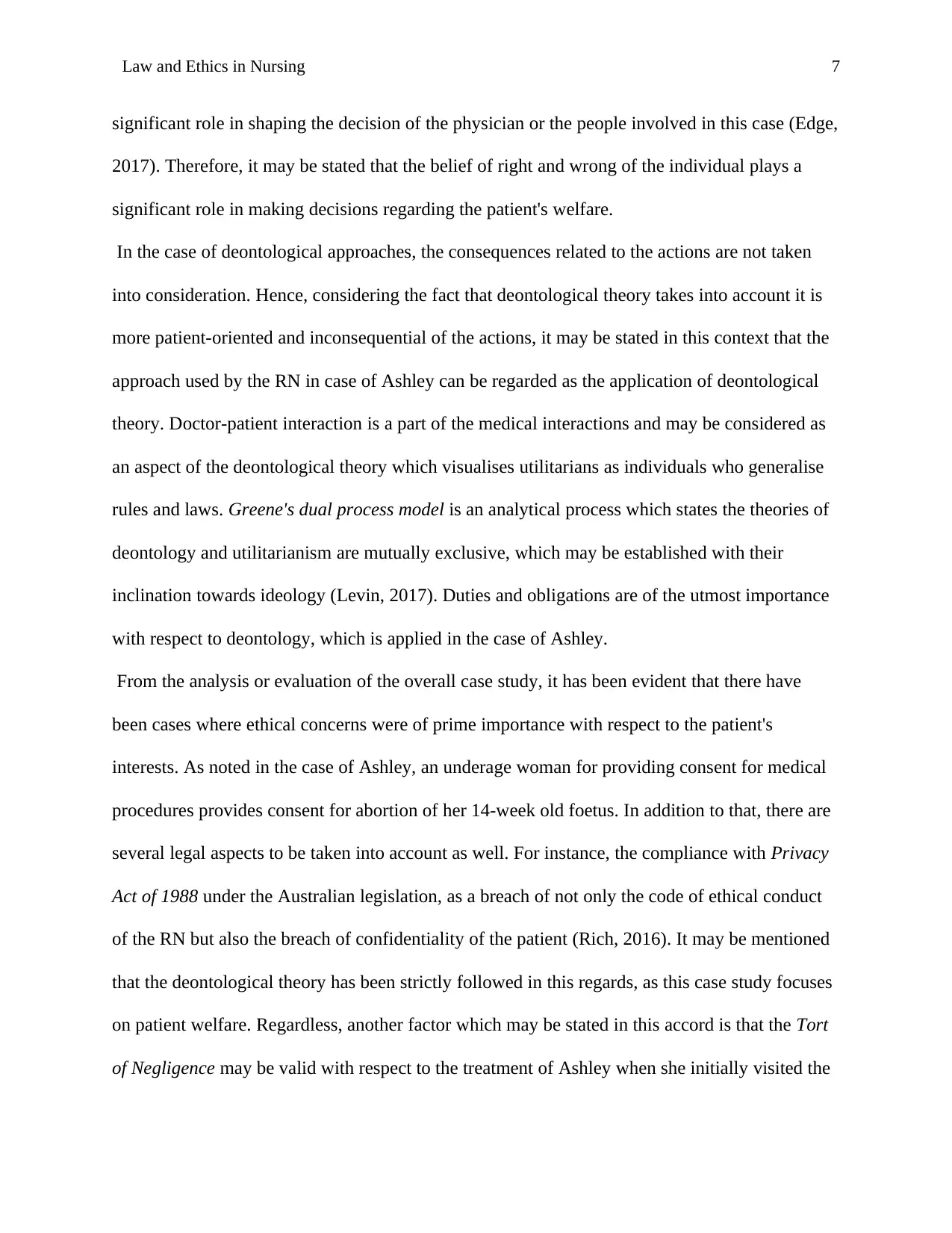
Law and Ethics in Nursing 7
significant role in shaping the decision of the physician or the people involved in this case (Edge,
2017). Therefore, it may be stated that the belief of right and wrong of the individual plays a
significant role in making decisions regarding the patient's welfare.
In the case of deontological approaches, the consequences related to the actions are not taken
into consideration. Hence, considering the fact that deontological theory takes into account it is
more patient-oriented and inconsequential of the actions, it may be stated in this context that the
approach used by the RN in case of Ashley can be regarded as the application of deontological
theory. Doctor-patient interaction is a part of the medical interactions and may be considered as
an aspect of the deontological theory which visualises utilitarians as individuals who generalise
rules and laws. Greene's dual process model is an analytical process which states the theories of
deontology and utilitarianism are mutually exclusive, which may be established with their
inclination towards ideology (Levin, 2017). Duties and obligations are of the utmost importance
with respect to deontology, which is applied in the case of Ashley.
From the analysis or evaluation of the overall case study, it has been evident that there have
been cases where ethical concerns were of prime importance with respect to the patient's
interests. As noted in the case of Ashley, an underage woman for providing consent for medical
procedures provides consent for abortion of her 14-week old foetus. In addition to that, there are
several legal aspects to be taken into account as well. For instance, the compliance with Privacy
Act of 1988 under the Australian legislation, as a breach of not only the code of ethical conduct
of the RN but also the breach of confidentiality of the patient (Rich, 2016). It may be mentioned
that the deontological theory has been strictly followed in this regards, as this case study focuses
on patient welfare. Regardless, another factor which may be stated in this accord is that the Tort
of Negligence may be valid with respect to the treatment of Ashley when she initially visited the
significant role in shaping the decision of the physician or the people involved in this case (Edge,
2017). Therefore, it may be stated that the belief of right and wrong of the individual plays a
significant role in making decisions regarding the patient's welfare.
In the case of deontological approaches, the consequences related to the actions are not taken
into consideration. Hence, considering the fact that deontological theory takes into account it is
more patient-oriented and inconsequential of the actions, it may be stated in this context that the
approach used by the RN in case of Ashley can be regarded as the application of deontological
theory. Doctor-patient interaction is a part of the medical interactions and may be considered as
an aspect of the deontological theory which visualises utilitarians as individuals who generalise
rules and laws. Greene's dual process model is an analytical process which states the theories of
deontology and utilitarianism are mutually exclusive, which may be established with their
inclination towards ideology (Levin, 2017). Duties and obligations are of the utmost importance
with respect to deontology, which is applied in the case of Ashley.
From the analysis or evaluation of the overall case study, it has been evident that there have
been cases where ethical concerns were of prime importance with respect to the patient's
interests. As noted in the case of Ashley, an underage woman for providing consent for medical
procedures provides consent for abortion of her 14-week old foetus. In addition to that, there are
several legal aspects to be taken into account as well. For instance, the compliance with Privacy
Act of 1988 under the Australian legislation, as a breach of not only the code of ethical conduct
of the RN but also the breach of confidentiality of the patient (Rich, 2016). It may be mentioned
that the deontological theory has been strictly followed in this regards, as this case study focuses
on patient welfare. Regardless, another factor which may be stated in this accord is that the Tort
of Negligence may be valid with respect to the treatment of Ashley when she initially visited the
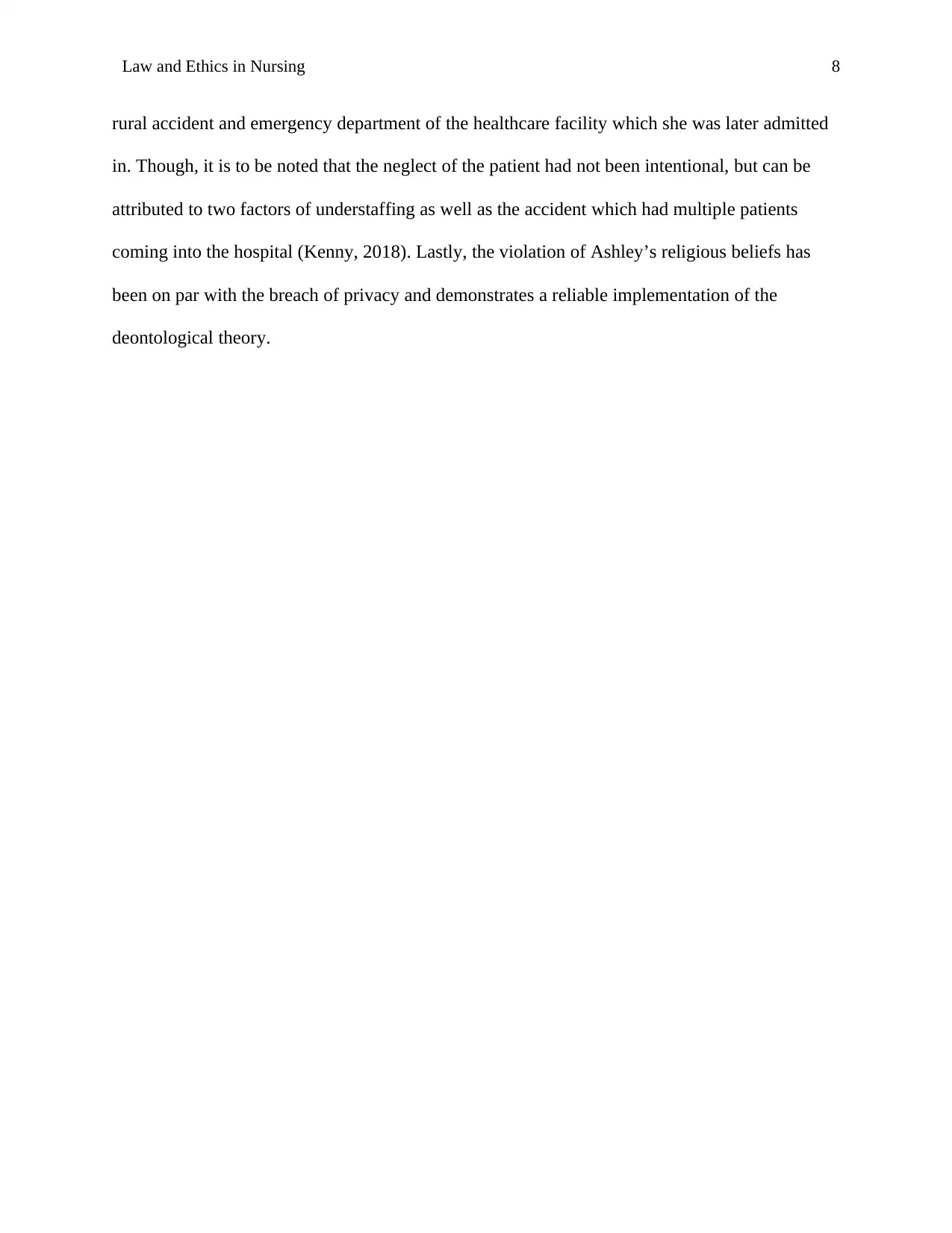
Law and Ethics in Nursing 8
rural accident and emergency department of the healthcare facility which she was later admitted
in. Though, it is to be noted that the neglect of the patient had not been intentional, but can be
attributed to two factors of understaffing as well as the accident which had multiple patients
coming into the hospital (Kenny, 2018). Lastly, the violation of Ashley’s religious beliefs has
been on par with the breach of privacy and demonstrates a reliable implementation of the
deontological theory.
rural accident and emergency department of the healthcare facility which she was later admitted
in. Though, it is to be noted that the neglect of the patient had not been intentional, but can be
attributed to two factors of understaffing as well as the accident which had multiple patients
coming into the hospital (Kenny, 2018). Lastly, the violation of Ashley’s religious beliefs has
been on par with the breach of privacy and demonstrates a reliable implementation of the
deontological theory.
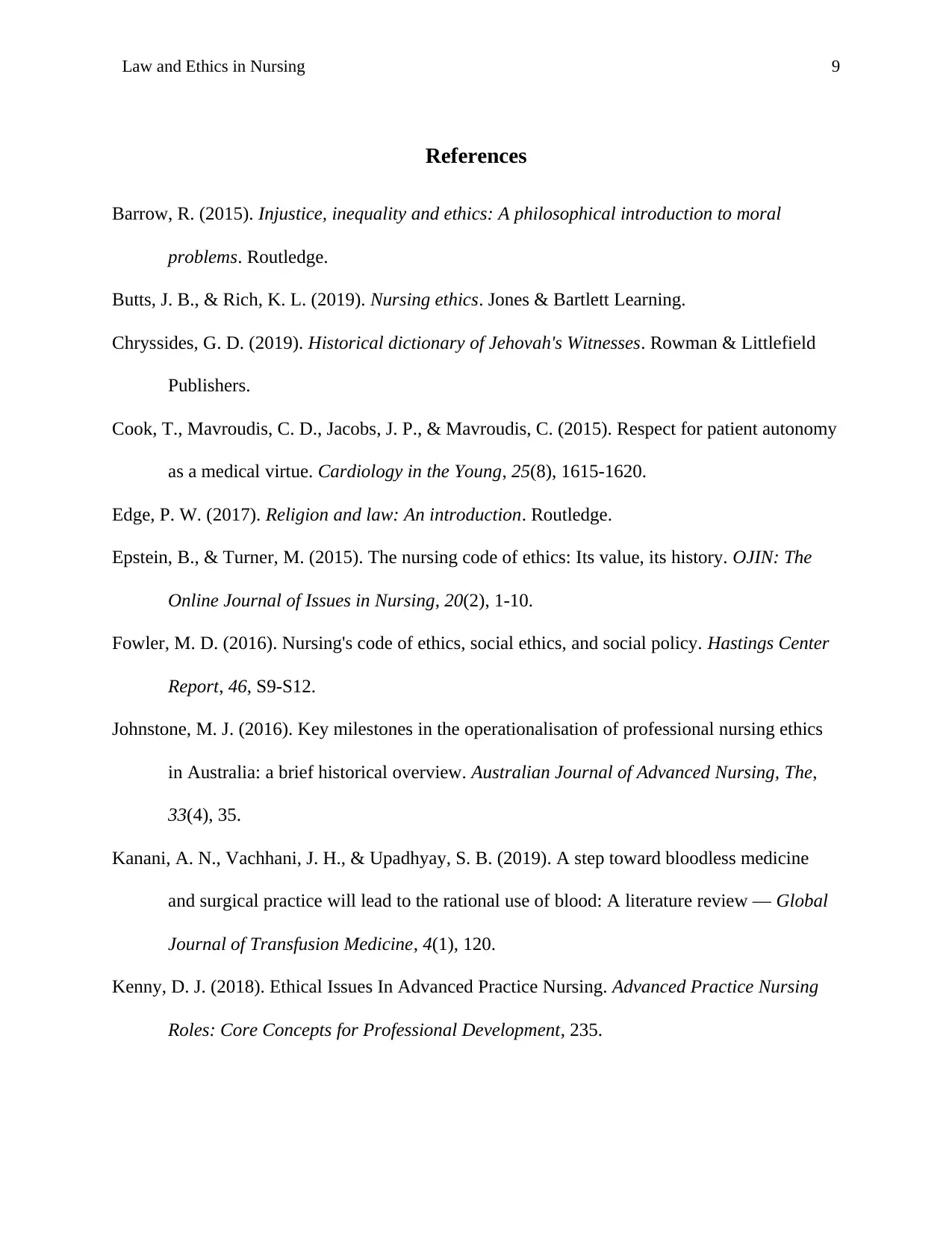
Law and Ethics in Nursing 9
References
Barrow, R. (2015). Injustice, inequality and ethics: A philosophical introduction to moral
problems. Routledge.
Butts, J. B., & Rich, K. L. (2019). Nursing ethics. Jones & Bartlett Learning.
Chryssides, G. D. (2019). Historical dictionary of Jehovah's Witnesses. Rowman & Littlefield
Publishers.
Cook, T., Mavroudis, C. D., Jacobs, J. P., & Mavroudis, C. (2015). Respect for patient autonomy
as a medical virtue. Cardiology in the Young, 25(8), 1615-1620.
Edge, P. W. (2017). Religion and law: An introduction. Routledge.
Epstein, B., & Turner, M. (2015). The nursing code of ethics: Its value, its history. OJIN: The
Online Journal of Issues in Nursing, 20(2), 1-10.
Fowler, M. D. (2016). Nursing's code of ethics, social ethics, and social policy. Hastings Center
Report, 46, S9-S12.
Johnstone, M. J. (2016). Key milestones in the operationalisation of professional nursing ethics
in Australia: a brief historical overview. Australian Journal of Advanced Nursing, The,
33(4), 35.
Kanani, A. N., Vachhani, J. H., & Upadhyay, S. B. (2019). A step toward bloodless medicine
and surgical practice will lead to the rational use of blood: A literature review — Global
Journal of Transfusion Medicine, 4(1), 120.
Kenny, D. J. (2018). Ethical Issues In Advanced Practice Nursing. Advanced Practice Nursing
Roles: Core Concepts for Professional Development, 235.
References
Barrow, R. (2015). Injustice, inequality and ethics: A philosophical introduction to moral
problems. Routledge.
Butts, J. B., & Rich, K. L. (2019). Nursing ethics. Jones & Bartlett Learning.
Chryssides, G. D. (2019). Historical dictionary of Jehovah's Witnesses. Rowman & Littlefield
Publishers.
Cook, T., Mavroudis, C. D., Jacobs, J. P., & Mavroudis, C. (2015). Respect for patient autonomy
as a medical virtue. Cardiology in the Young, 25(8), 1615-1620.
Edge, P. W. (2017). Religion and law: An introduction. Routledge.
Epstein, B., & Turner, M. (2015). The nursing code of ethics: Its value, its history. OJIN: The
Online Journal of Issues in Nursing, 20(2), 1-10.
Fowler, M. D. (2016). Nursing's code of ethics, social ethics, and social policy. Hastings Center
Report, 46, S9-S12.
Johnstone, M. J. (2016). Key milestones in the operationalisation of professional nursing ethics
in Australia: a brief historical overview. Australian Journal of Advanced Nursing, The,
33(4), 35.
Kanani, A. N., Vachhani, J. H., & Upadhyay, S. B. (2019). A step toward bloodless medicine
and surgical practice will lead to the rational use of blood: A literature review — Global
Journal of Transfusion Medicine, 4(1), 120.
Kenny, D. J. (2018). Ethical Issues In Advanced Practice Nursing. Advanced Practice Nursing
Roles: Core Concepts for Professional Development, 235.
Secure Best Marks with AI Grader
Need help grading? Try our AI Grader for instant feedback on your assignments.
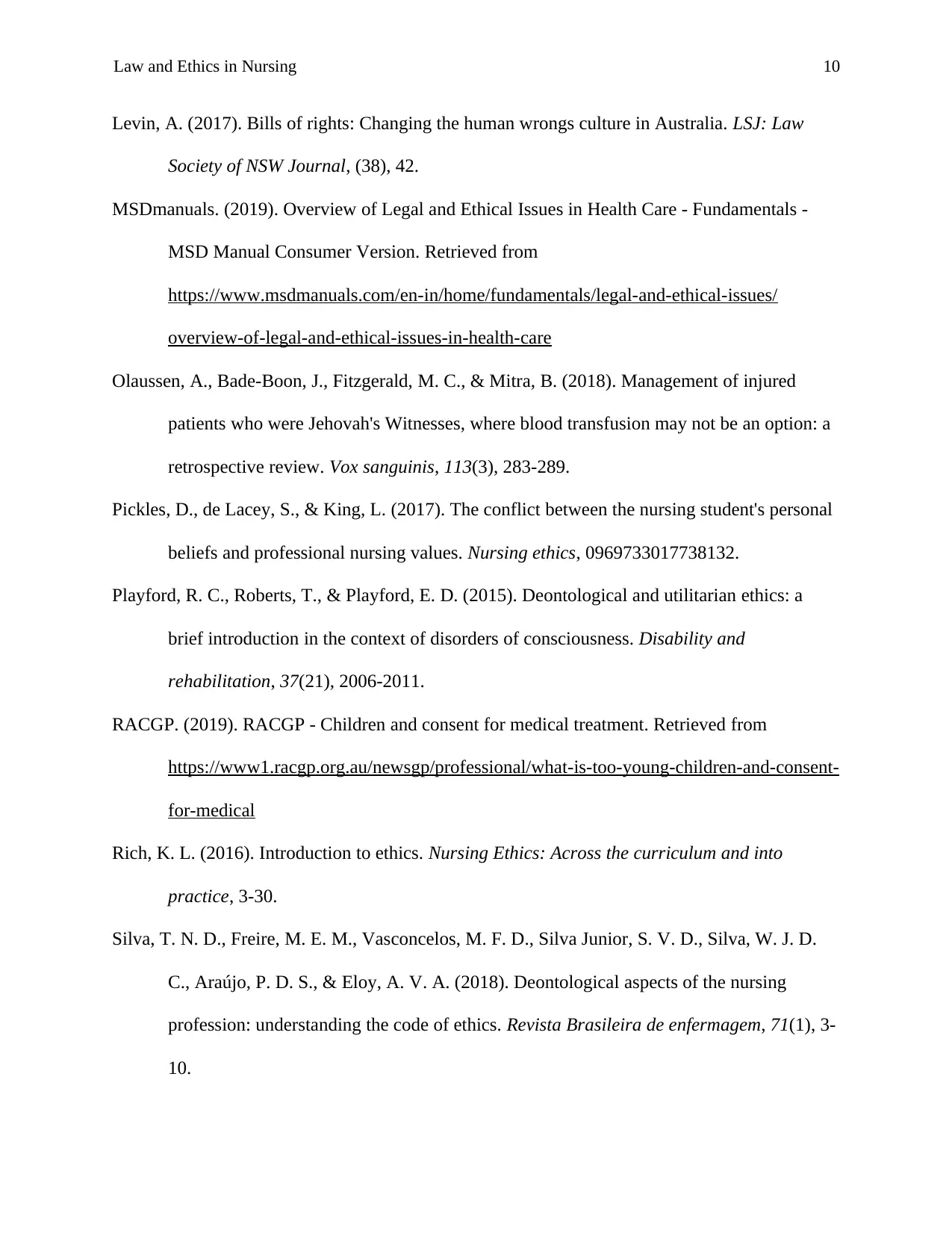
Law and Ethics in Nursing 10
Levin, A. (2017). Bills of rights: Changing the human wrongs culture in Australia. LSJ: Law
Society of NSW Journal, (38), 42.
MSDmanuals. (2019). Overview of Legal and Ethical Issues in Health Care - Fundamentals -
MSD Manual Consumer Version. Retrieved from
https://www.msdmanuals.com/en-in/home/fundamentals/legal-and-ethical-issues/
overview-of-legal-and-ethical-issues-in-health-care
Olaussen, A., Bade‐Boon, J., Fitzgerald, M. C., & Mitra, B. (2018). Management of injured
patients who were Jehovah's Witnesses, where blood transfusion may not be an option: a
retrospective review. Vox sanguinis, 113(3), 283-289.
Pickles, D., de Lacey, S., & King, L. (2017). The conflict between the nursing student's personal
beliefs and professional nursing values. Nursing ethics, 0969733017738132.
Playford, R. C., Roberts, T., & Playford, E. D. (2015). Deontological and utilitarian ethics: a
brief introduction in the context of disorders of consciousness. Disability and
rehabilitation, 37(21), 2006-2011.
RACGP. (2019). RACGP - Children and consent for medical treatment. Retrieved from
https://www1.racgp.org.au/newsgp/professional/what-is-too-young-children-and-consent-
for-medical
Rich, K. L. (2016). Introduction to ethics. Nursing Ethics: Across the curriculum and into
practice, 3-30.
Silva, T. N. D., Freire, M. E. M., Vasconcelos, M. F. D., Silva Junior, S. V. D., Silva, W. J. D.
C., Araújo, P. D. S., & Eloy, A. V. A. (2018). Deontological aspects of the nursing
profession: understanding the code of ethics. Revista Brasileira de enfermagem, 71(1), 3-
10.
Levin, A. (2017). Bills of rights: Changing the human wrongs culture in Australia. LSJ: Law
Society of NSW Journal, (38), 42.
MSDmanuals. (2019). Overview of Legal and Ethical Issues in Health Care - Fundamentals -
MSD Manual Consumer Version. Retrieved from
https://www.msdmanuals.com/en-in/home/fundamentals/legal-and-ethical-issues/
overview-of-legal-and-ethical-issues-in-health-care
Olaussen, A., Bade‐Boon, J., Fitzgerald, M. C., & Mitra, B. (2018). Management of injured
patients who were Jehovah's Witnesses, where blood transfusion may not be an option: a
retrospective review. Vox sanguinis, 113(3), 283-289.
Pickles, D., de Lacey, S., & King, L. (2017). The conflict between the nursing student's personal
beliefs and professional nursing values. Nursing ethics, 0969733017738132.
Playford, R. C., Roberts, T., & Playford, E. D. (2015). Deontological and utilitarian ethics: a
brief introduction in the context of disorders of consciousness. Disability and
rehabilitation, 37(21), 2006-2011.
RACGP. (2019). RACGP - Children and consent for medical treatment. Retrieved from
https://www1.racgp.org.au/newsgp/professional/what-is-too-young-children-and-consent-
for-medical
Rich, K. L. (2016). Introduction to ethics. Nursing Ethics: Across the curriculum and into
practice, 3-30.
Silva, T. N. D., Freire, M. E. M., Vasconcelos, M. F. D., Silva Junior, S. V. D., Silva, W. J. D.
C., Araújo, P. D. S., & Eloy, A. V. A. (2018). Deontological aspects of the nursing
profession: understanding the code of ethics. Revista Brasileira de enfermagem, 71(1), 3-
10.
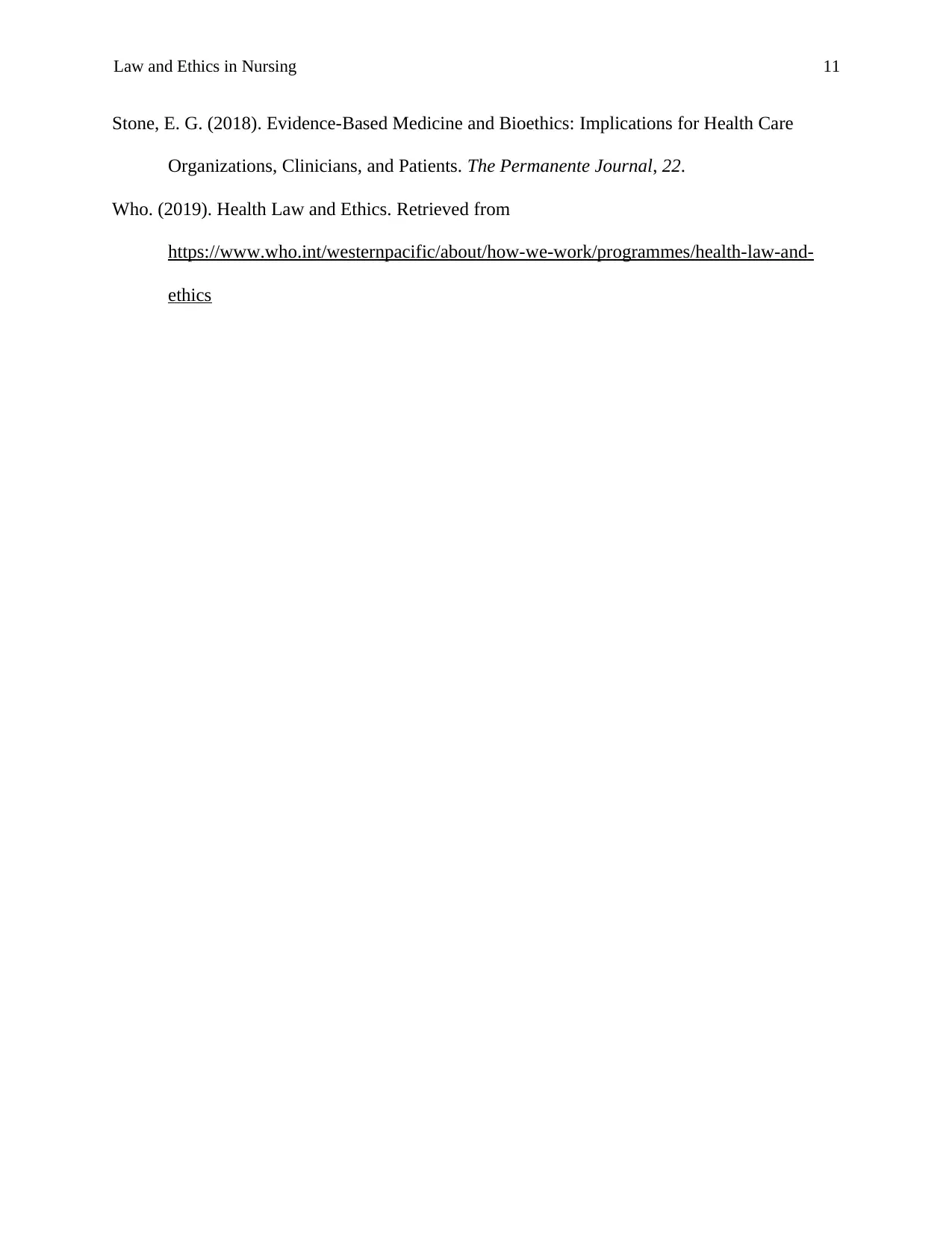
Law and Ethics in Nursing 11
Stone, E. G. (2018). Evidence-Based Medicine and Bioethics: Implications for Health Care
Organizations, Clinicians, and Patients. The Permanente Journal, 22.
Who. (2019). Health Law and Ethics. Retrieved from
https://www.who.int/westernpacific/about/how-we-work/programmes/health-law-and-
ethics
Stone, E. G. (2018). Evidence-Based Medicine and Bioethics: Implications for Health Care
Organizations, Clinicians, and Patients. The Permanente Journal, 22.
Who. (2019). Health Law and Ethics. Retrieved from
https://www.who.int/westernpacific/about/how-we-work/programmes/health-law-and-
ethics
1 out of 12
Related Documents
Your All-in-One AI-Powered Toolkit for Academic Success.
+13062052269
info@desklib.com
Available 24*7 on WhatsApp / Email
![[object Object]](/_next/static/media/star-bottom.7253800d.svg)
Unlock your academic potential
© 2024 | Zucol Services PVT LTD | All rights reserved.





